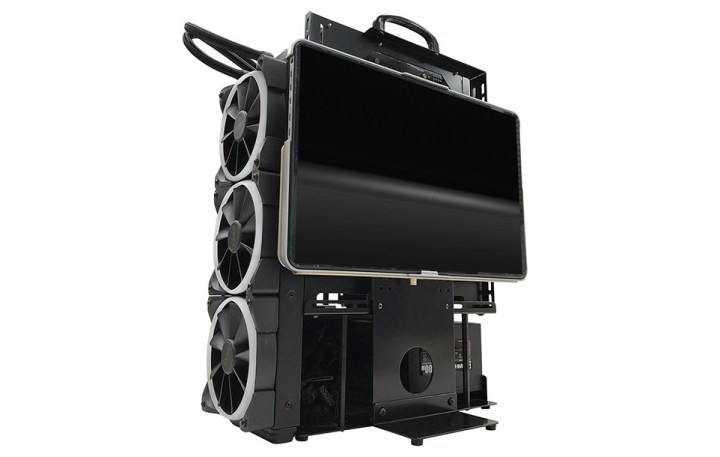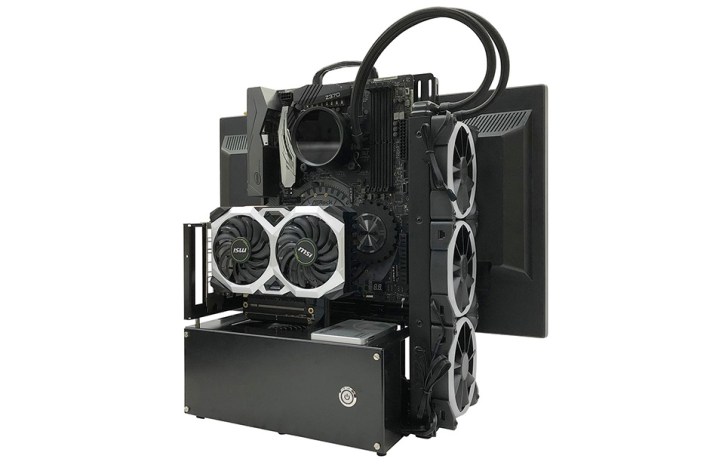If you’re a fan of unusual PC builds, you might like this fresh release from Nagao Seisakusho, a Japanese open-frame chassis specialist. Instead of locking all of the components inside the chassis, Nagao sets them free — and this time around, the company spiced up the build with an unexpected detail.
Nagao has just unveiled a monitor mounting bracket that goes with its open-air chassis, allowing customers to build a fully portable all-in-one PC by themselves.

Nagao is a brand that makes open-air chassis for all kinds of motherboard sizes and use cases, including standard ATX, Micro-ATX, and Mini-ATX motherboards. The company has several options up for grabs that let users customize its PCs beyond what a typical chassis usually allows.
First spotted by @momomo_us on Twitter, and referred to as the “N-Frame PC chassis,” these open-air “cases” let you build your PC from scratch in a neat way.
As seen in the images that include the mounting bracket, the result is unlike anything else we’ve seen. The photos show off the potential of the chassis, with a massive graphics card completely unrestrained by the size of the motherboard. The monitor is suspended on the side of the chassis, with the motherboard and the components directly behind it. The whole setup is highly upgradeable, easy to monitor, and in all likelihood, delightfully easy to clean. (Did you know that you should be cleaning the inside of your PC once every few months?)
Typically, the best all-in-one PCs tuck the components away within the screen, much like the gorgeous 24-inch Apple iMac. On the other hand, it’s hard to deny that Nagao’s vision definitely scores some points when it comes to uniqueness, and for the actual performance of the PC, it’s certainly helpful. Instead of cramming things into an ultra-tight space, the components get plenty of cooling just from being out in the open.
Although Nagao’s products seem like a lot of fun to an enthusiast PC builder, they’re not directly available in the U.S. However, you can check them out on the Japanese version of Amazon if you’d like to give them a try. A Nagao Open Frame Micro-ATX chassis costs 14,955 Japanese yen, which amounts to around $112.

Ditching the chassis when building a new PC certainly has a range of benefits, from an increase in airflow to the fact that it just looks pretty cool. It’s also easier when you don’t have to worry about the size of the components quite as much, and cable management becomes less of a problem when you have plenty of space and options to organize them. What’s more, servicing an open-frame PC is fairly easy — after all, it’s all out there in the open right within reach. However, builds like Nagao’s are not without their issues, and seeing a handle on top of the PC — especially with a monitor mounted to it — brings up the question of safety.
Undoubtedly, Nagao will have tested the hardware prior to ever releasing it. It’s still a little scary to imagine what could possibly happen if the monitor ends up weighing more than the rest of the chassis, which, depending on the size of the screen, is entirely possible. The monitor bracket has 75 x 75 and 100 x 100 VESA mounting holes which could translate to a fairly big display.
Once an all-in-one PC is built based on Nagao’s products, it can be taken anywhere with ease thanks to the added handle. This, again, can make one feel a little apprehensive. Imagine the slightest bit of spillage or accidentally getting your beastly graphics card scratched… It’s not likely, but it could happen. If you wanted to try this out for yourself, you’d have to weigh the pros and cons and decide just how much portability you want to risk with your one-of-a-kind build.
Editors’ Recommendations




